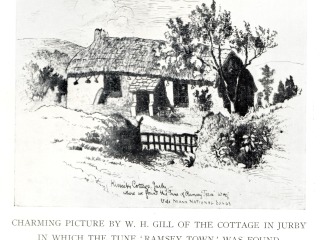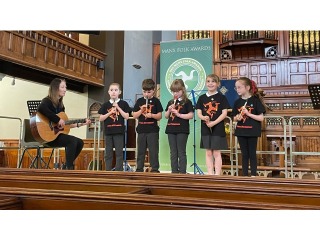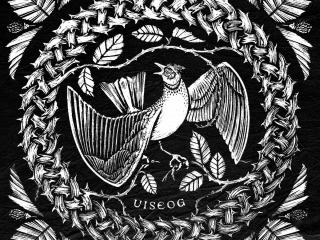MENU
26 Apr 2016
‘Peeps into the Past’ article in The Courier [Isle of Man] 1967
by Syd Boulton
The Sound of Music – in Mann
p. 7, Friday, 20th January, 1967
THE SOUND OF MUSIC – IN MANN
A Long Standing Tradition
THE Island through its Music 'Guild' which began in 1892 has long had the reputation of maintaining a high standard of music and if we look through the records of earlier times it is evident that the Manx were a musical people with their own ballads and carvals (carols) and folk tunes some of which have been rescued from oblivion by the patient work of people like Dr. John Clague and Miss M. L. Wood.
Miss Wood was regarded as the “Mother of Music” in the Island - it was mainly through her efforts that the Music Guild was started and she spent the whole of her life here teaching choirs and solo singers, playing Church organs, and reviving musical traditions.
In January 1896, she gave a paper before the Tonic Sol Fa Convention entitled “Music Past and Present in the Isle of Man.”
She pointed out that it was on record by Chaloner that in the middle of the 17th century there was scarcely a family on the Island who had not a violin player in their midst.
David Craine in 'Manannan's Isle' said that violins and viols were the only musical instruments mentioned in those early times. The fiddlers who played at gatherings in the Island generally went in pairs and often travelled long distances to fulfil engagements.
At church services it was the job of the Parish Clerk to 'raise the tune' for the singing and he also had to sing psalms at a funeral procession.
It is recorded at St. Paul's, Ramsey, that in 1845 £4.16.3 was paid for a clarionet. Music was also provided by Mr Killip, Clerk, who played the Bass fiddle and Mr John Boyde who played a twisting instrument called the 'serpent.'
An organ was not installed until 1852.
At St. Mary's, Ballure, a large Psalmadic or Barrel Organ was brought into use in 1787 and it was the first instrument of its kind in the Island. The Psalm tunes were composed by Dr. Miller, organist of York Minster, who did not publish the tunes at first but put them into the Barrel Organs.
A writer named Quayle, referring in 1812 to harvest festivals said “English country dances were unknown but jigs or reels in which four or five couples joined took their place, the fiddler changing his tune and often playing one of the few national lively airs preserved from early times and resembling the Irish strongly in character.”
FOUR PART SINGING
At the end on the 18th century a Cunbrian [sic. Cumbrian] named Shepherd introduced four part-singing. He taught choirs in the various parishes and his terms were 10s. per head per quarter and 1s. for his book, this book being in his own handwriting on foolscap and lined with a five-pronged pen, the words also being clearly transcribed.
He taught each part separately keeping the other parts outside until required to sing together.
The females took the tenor part in those days and the tenor voices sang the air.
Shepherd beat time by opening and shutting his hand. He had a curious tubular wooden pitch-pipe. No other instrument was in fact used in Churches for many years.
The bass fiddle was then used as being 'less secular' than the violin, and clarionets and bassoons were added and gradually organs were introduced.
In Rushen Parish Church the instruments used were a clarionet and bass fiddle, in St. Paul's, Ramsey (referred to earlier in this article), the bass fiddle, clarionet and serpent were in use. Sometimes in Rushen a flute was played and the clarionet was used to give the note. Hymns were given out four lines at a time.
In Ballaugh Parish Church the instruments to be found were a cornopean (cornet) and a bass fiddle.
At Kirk Michael Church a bass fiddle, flute and trombone formed a curious combination.
At Arbory Church the old clerk, nearly 80 years of age, vainly imagined that he was a good singer and he always treated the congregation to the first verse of the psalm as a solo! Sometimes the congregation cringed when he did this!
Here the men of the choir sang on one side of the west gallery and the women on the other.
And whenever the females sang alone (their singing was always accompanied) they turned their backs on the congregation!
FIRST ORGAN
The first organ was introduced into the Isle of Man in the Government Chapel of St. Mary's, Castletown, about 1811.
The next to appear was in St. George's, Douglas, and of course this set the fashion and in the years following builders were busy putting in Church organs.
According to a book dated 1812 anthems were in use. The ordinary hymns were Tate and Brady's version of the psalms translated into Manx and the tunes commonly used were the English ones with repeats.
At Kirk Braddan where the services were alternately Manx and English there was an old clerk who was fond of inventing tunes as he went along and when asked for the source he would say they were, 'real Manx.'
On the occasions of executions at Castletown the gallows were erected at a place near where the railway station stands and it was an invariable custom on this grim occasions to sing the 51st Psalm, 'Have mercy upon me O God.' And the Parish Clerk would sometimes strike the tune.
Shepherd did much good work in the Island in teaching four-part singing and he was followed by a man named Cretney who used what was known as the 'Hullah' method. He took large classes and was quite successful in getting choirs together.
There are many stories told about the singing of carvals on Christmas Eve.
It was the custom to have an Oiel Voirree (Hail Mary) service.
CAROLS BY CANDLELIGHT
People made their own candles for it and carried their lights to Church. In Ballaugh they vied with each other as to who could make the thickest candle. These candles were often fixed on nails driven into the ends of the pews.
The evening service over, the parson would take off his surplice and he would announce that anyone who chose might sing carols.
As can be imagined the custom led to abuse and one band of singers trotted out a carol which made reference to all the wicked women in the Bible.
In Malew Church one local character known as 'Tom the Dipper' announced his carol as 'The Bloody Gardener' and he had to be stopped for brawling.
These carols were often sung as solos for thirty or forty verses. A man who was once silenced at the 25th verse began his carol the next year at the point at which he had been stopped!
In later years one or two choirs sang alternate anthems or carols, one on the gallery and another in the chancel.
But because of irreverence the Christmas Eve services were discontinued.
IN THE SCHOOLS
In her paper given in 1896, Miss Wood stated that 40 years previously only one or two of the elementary schools taught singing by note. But a check taken during 1896 showed that there were 72 elementary schools in the Island teaching about 9,000 children and of these 51 in the previous year had earned what was known as the 'note singing grant' and 20 a grant for singing by ear.
Church music was reported to be slowly improving in standard, it was hoped to have a diocesan festival to improve matters further and the Wesleyan Society also proposed to form a society with the aim of improving music in the Chapels.
Brass band contests held annually in November were doing something to revive village bands which had fallen by the way in some places.
Then Gill's Manx Song Book was published in 1896.
Doctor John Clague did a great deal in collecting almost forgotten songs and airs for the book. Between 1890 and 1896 he collected more than 300 tunes.
A large number were taken down by him from the blind Thomas Kermode, a fisherman of Bradda.
The doctor himself was an expert musician and was responsible for creating a hymn tune – Crofton - 'Glory to Thee my God this night,' which has been included in several collections.
William Henry Gill was regarded as 'our most expert and scholarly musician.' He published over 200 melodies and he will always be remembered as the author of the Manx Fisherman's Evening Hymn.
One of his discoveries was the tune 'Ramsey Town' which was unearthed in Kissack's cottage in Jurby.
A Dalby farmer and local preacher, Thomas Quane, provided another notable folk-song. It had never been recorded and Quane had no words for it but as a preacher he had sung it to words in the hymn book. He gave the air to Miss Kate Morrison.
The story of its origin was that the song 'Arrane Ghelbee' would be heard over the waters from an old man with white hair when he was sailing his boat from Bradda to Niarbyl.
He was supposed to have rowed towards Ireland and was never seen again but someone remembered the air, the people of Dalby began to sing it and taught it to their children and then on to the next generation and so the air was preserved.
Reference has been made to the Parish Clerk.
He was a person who more than a century ago was very important in regard to music.
At a time when only a proportion of the country people were conversant with English he read the psalm for the day, line by line, and then striking the tune he would get the congregation to sing with him.
So if the Parish Clerk was endowed with a musical voice he was worth his weight in gold.

'Ramsey Town - the Manx favourite sung with gusto island-wide'
23 Apr 2025
Read More...
Manx Folk Awards 2025 RESULTS
01 Apr 2025
Read More...
Little Red Bird - the island's most popular and well-travelled lullaby
31 Mar 2025
Read More...
Contact, Links, Acknowledgements, Privacy
© Culture Vannin. Culture Vannin is the trading name for the Manx Heritage Foundation, registered charity 333 in the Isle of Man. Designed by 3 Legs Ltd.